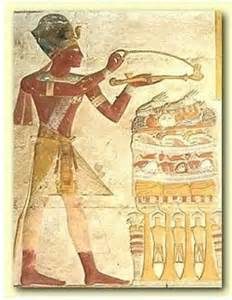
An ancient form of perfuming a body and a space, incense releases fragrance through heat and smoke, evoking the meaning of the word perfume. From the Latin per-fumum the word means ‘through smoke’ and refers to the original transformation of fragrant material into visible scent. Long used in religious ceremonies, incense is also valuable for scenting personal space. For this Perfumer’s Workshop, we ask four fragrance artists to help us understand more deeply the art of incense-making.
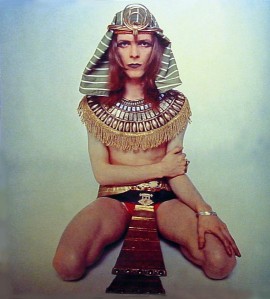
David Bowie as The Sphinx 1971 Brian Ward Photo
David Bowie said: “I’m in awe of the universe, but I don’t necessarily believe there’s an intelligence or agent behind it. I do have a passion for the visual in religious rituals, though, even though they may be completely empty and bereft of substance. The incense is powerful and provocative, whether Buddhist or Catholic”.
Dr. Elise Pearlstine: When did you first become interested in making incense and why?

JK DeLapp
JK DeLapp of The Rising Phoenix Group: I’ve loved incense ever since I was a kid. Catholic Church was probably the first place I ever experienced it. Spent time living in France and Prague shortly after university – and I used to love spending time simply sitting in any active churches I could find. Even the old spaces no longer in religious use would have a lingering scent of resins in the old stone and beams, especially when it got warm.
I spent some time working in Shanghai, and while in China, would “follow my nose” everywhere I went to find the local temples. I could find a temple from about 10 blocks away just by following my nose! Then there are the Japanese Senko and Tibetan incense that I’ve loved for as long as I could remember! I still have an ongoing love affair with these two compounding traditions…
It wasn’t until I was in Chinese Medical School, when I had just about everything you could imagine at my fingertips, that I actually stepped beyond heating resins or woods on charcoal to actually compounding more refined compositions. I’ve come a long way since then!
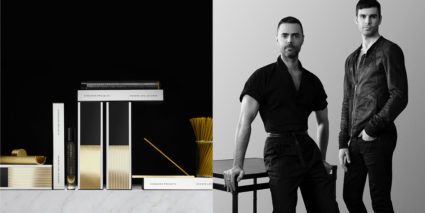
Cinnamon Projects Andrew Cinnamon and Partner Charlie Stackhouse
Andrew Cinnamon of Cinnamon Projects: Growing up opposite sides of the globe, Charlie and I were each obsessed with the balance of beauty, science and experience. I would sketch and catalog my world. He would experiment in the lab. We both ended up in art school and found our own ways to create experience. We met in 2008, began working together and opened our creative agency, Cinnamon Projects, to work with creative entrepreneurs in launching new businesses. In 2012, we decided to focus a share of our time on developing our own ideas. Series 01, our fragrance project, began as a conceptual project with the goal of exploring the nature of our shared creative inspiration and developing a new process and medium for our personal projects. Over a year’s time, we cataloged the content that “moved” us. Art, photography, architecture, design and textiles, typography and graphics, poetry, writings about creativity, science, technology and space are the mix. We annotated every entry with the time and date of collection, subject category, visual details and a handful of much more subjective impressions. With no strict parameters our archive is very free, unedited and, most importantly, emotional.
When the collecting stopped and the decoding began, we filtered the archive in what we felt would be the most neutral … the hour of day. We immediately discovered that each hour had a unique character. For example, 7AM is sharp, pale and architectural. 11PM is grainy, saturated and sensual.
The common thread we discovered is that our inspiration is consistently draws from experience and memory. Excited by the process of discovery, we set out to distill our archive of images into an ephemeral, sensorial and sharable format. As one’s sense of smell is the most powerful to provoke memory and inspire emotion, we turned to fragrance as a medium. The Series 01 Incense and Accords formulas were developed over the following year and we launched our collection in 2014.
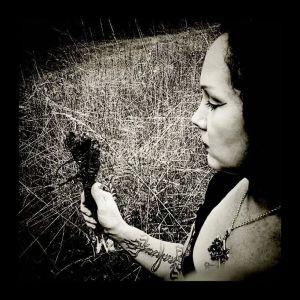
Catamara Rosarium
Catamara Rosarium of Rosarium Blends: I first became interested in making incense approximately 15+ years ago. Initially I found in ritual and magic the use of burning incense as an offering in devotion, cleansing, and in assistance to elevate the success of and assist in various magical operations. This passion was a result of a profound immersion of various occult (ie; hidden mysteries as by definition of the term) and esoteric herbal studies and praxis, resulting in ritual art and my passion for making herbal concoctions. Inevitably I became deeply obsessed with the ancient arts and sciences of alchemy and esoteric herbal arts and became a master herbalist, root-worker and master in the wortcunning tradition of incense.
These experiences led to me creating my own incense blends for personal use in ritual and magic, and eventually to the creation and success of my business Rosarium Blends, now 7 years old.
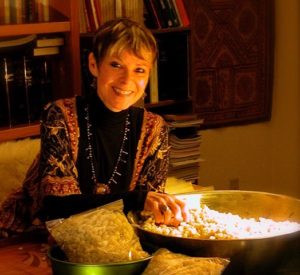
Katlyn Breene of Mermade Magickal Arts
Katlyn Breene of Mermade Magickal Arts: Incense is so elemental, it can be a spiritual path akin to alchemy. When one combines the fragrant gifts of earth and water with fire and air a transformation happens – an offering of sacred smoke is created. I think of incense as a “perfect prayer”.
Does the structure differ from perfumes? Why do you like it as a medium?
Katlyn: When one wears perfume it is to please ourselves or those around us, when we burn incense it not only pleases us, it sends a message skyward. It blesses, purifies, heals and brings joy to the spirit.
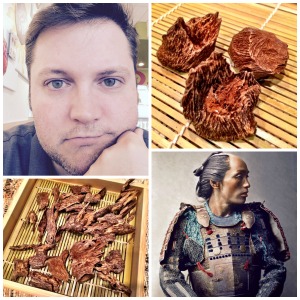
JK: Yes and no. The structure of incense needs to be built on the backbone of wood (historically – sandalwood and agarwood in the East, among others). Resins don’t burn so well in high concentration. They function more like accenting materials – unless we are talking more about the Arabic tradition of Bakhoor compounding, which involves burning on coals – rather than gentle heating on indirect heat (like the Japanese), or in a stick/joss/senko format. Structurally – I rely more on my training in Chinese Medicine, thinking in terms of Chief Herbs, Assistants, Envoys, etc. We were trained heavily in formulary compounding, and I rely on that training heavily. Then there are purely functional ingredients, like bamboo charcoal, Makko / Laha – these kinds of materials may not have an equivalent in perfumery compounding, since we don’t need to worry about moisture, combustion, or cohesion of the materials like we do in stick or Nerikoh form – let alone temperature regulation to gently peel away the layers, as in Kodo-style heating.
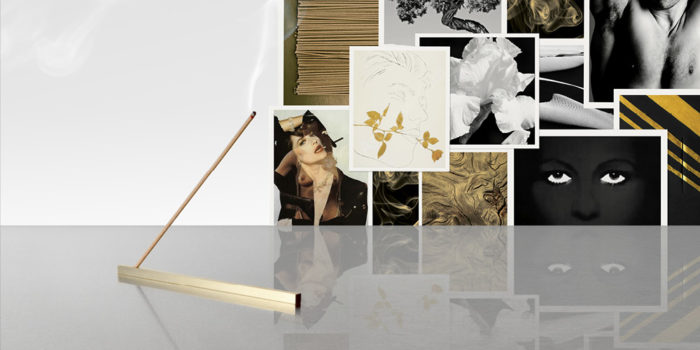
Cinnamon Projects Story Board for Incense
Andrew: As absolute beginners in fragrance creation, we relied on the images and annotations to suggest the actual fragrance notes and format. Our role was to blend, refine and strike a provocatively beautiful balance. Our Incense formulas reflect the hours filled with the abstract and atmospheric inspiration.
The Accords formulas reflect the hours filled with the human and sensual, specifically portraiture. For this reason, we think of the Incense as a stage and the Accords as the players and we approached the scent’s development with that in mind. With its seductive smoke and rituals, fabled history and potential to inspire and create collective atmosphere, incense was an irresistible canvas. The material / structural purity of Japanese-style incense served as an ideal medium for exploring an innovation we have dubbed Dynamic Diffusion. Similar to a perfume, our incense is composed to release different notes as it burns.
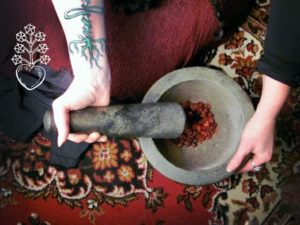
Catamara The Tools of a Witch mortar and pestle
Catamara: My path upon the art of incense making differs greatly from that of popular perfumery. All of my formulas are magical charms and are talismanic. They have been created with very specific intentions and formulated using magical theory, correspondences and astrological and lunar timing specific to the properties they embody. They will work on a subtle level even if burned without intention. I do not simply mix plants together because they smell nice together or work in accordance of the perfume organ. I focus first on the energy I want to embody and alchemicalize by combining what I know of each ingredient with the other.
Incense was the original ‘perfume’ and I find the true art is in incense. Alchemically speaking, an essential oil is one part of the plant extracted. With this, one could argue that the magical properties are limited to that of the part contained in the oil, often times there are subtle notes lost when separated from the plant. I like working with incense as a medium because the options to choose from for ingredients is endless. In perfumery the perfumer is limited to working with essential oils and alcohol to carry the scent. In incense, every part of a plant may be used in the creation of a blend if the artist desires. Rosarium Blends incense formulas vary but may include the combinations of many plant ingredients, combining leaf, thorn, vine, root, flower and seeds and the inclusion of essential oils.
Several of my perfumes and perfume oils were created as a companion to the incense. If you were to smell the oil and incense side by side they would not be exact because as I mentioned before the essential oil is one part of the plant extracted from it. However, they are very close and I strive for both mediums to embody the same result.
Do you have an ingredient or ingredients important in your incense-making?
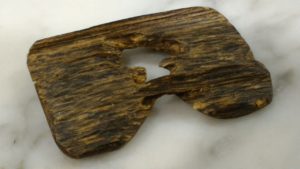
Rising Phoenix Group Agarwood
JK: I err more towards Japanese and Arabian compounding styles, which rely more heavily on Sandalwood and Agarwood-based compositions (as well as Junipers and Cedars). I enjoy Listening to more American indigenous blends – but I don’t enjoy making them so much. The Japanese and Arabian compositions are much more of a thrill and a challenge for me. So, in short – Sandalwood and Agarwood, as they form the foundation upon which I build – both in my incense work, as well as my perfumery composing. They are my preferred canvas.
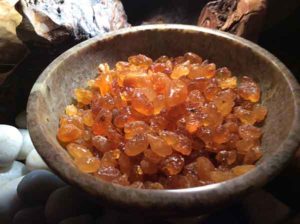
Frankincense Resins from Mermade Magickal Arts
Katlyn: Resins are my first love and frankincense the heart of my blends. It has so many faces and scent profiles. From sweet to dry, citrus to balsam – it is the classic scent that we recognize as being “incense” The look and feel of it is transporting as well, the colors and the translucent gem like qualities are mesmerizing. Other favorite botanicals that I could not create without—the amber sweetness of benzoin and labdanum, the melancholy beauty of myrrh, the fresh jammy scents of fir balsam and spruce, the healing medicine of Palo Santo and white sage and of course the precious woods of agar and sandal that hold the blend and make it into something rare and full. …there are many, many more and most of my blends have at least 10 to 15 ingredients.
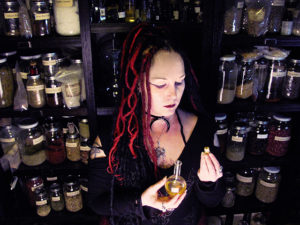
Catamara and her ingredients
Catamara: In my incense creations, every ingredient is important. The synergy of each part included represents a magical counterpart that helps embody the charm I aim to create.
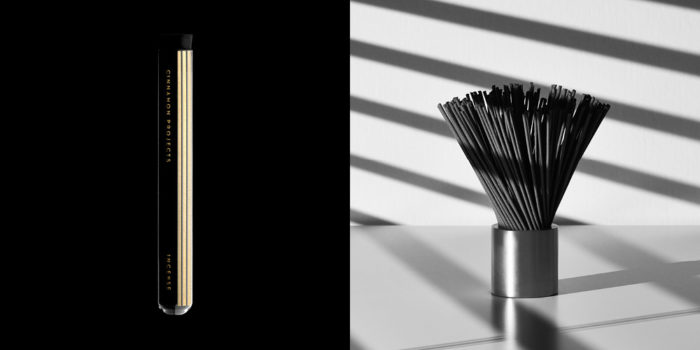
Cinnamon Projects Incense Sticks
Andrew: Through a process with considerable trial and error, the final Series 01 formulas rely on natural ingredients and premium accords to strike a harmony of fragrant and emotional potency. Charlie, the former child “mad scientist”, is always drawn to notes like benzoin and clay that have a hint of burn. I love the notes that conjure up memories of debaucherous nights, clove and night-blooming jasmine are my current favorites.
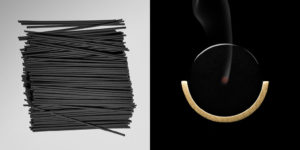
Cinnamon Projects Incense theme
Do your creations follow themes or patterns?
Andrew: Series 01 is a distillation of inspiration tied to memory.
Our next series explores the concept that scent may be used to provoke moments of intention. Forgoing nostalgia, the new scents serve to remind one of their potential to create the present. With our current global climate of social and political division, we felt inspired to focus on that which ties us together. The first scent of the series is titled I Feel Love. It is warm and energetic.
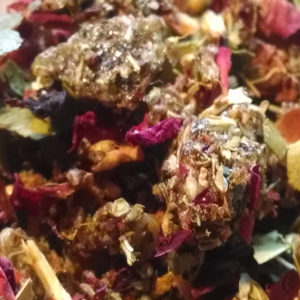
Rosarium Blends Aphrodite incense
Catamara: Every plant has specific properties that can be worked with magically. My formulas are first determined by researching all plants I want to include in the charm. I then consider the planetary influences, any folklore and mythology and how they specifically relate (in varying ways) to the formula I wish to create. The process of knowing how much of each herb I select to blend thereafter is an intuitive process are based upon a myriad of other esoteric correspondences. Perhaps one of my favorite parts of the incense making process is evolving and creating the intention and theme. Working to find the perfect match of vision, purpose and fragrance. Most know I am a very visual person so the image the scent conjures is very meaningful to me, as I hope it is to my customers. Conjure is a key word, to weave an enchantment with scented smoke that invokes a mood, a spell or even a goddess. My incense is not compounded until the name and intention are fully formed.
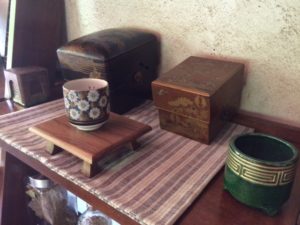
JK’s antique Japanese Incense Collection
JK: Absolutely! I have a tendency to compose using historical times or places as inspiration. I love to read, and so I happen across quite a few references, which usually get the wheels turning. When I list items, I generally try to spell out the inspiration in a story format, and use them as opportunities to educate my customers along the way about long forgotten places and traditions. Many of my clients tell me that the descriptions of my products are almost as enjoyable as the products, themselves.
With that being said – I also take quite a few liberties in drawing upon historical practices and creating compositions uniquely mine – not unlike fusion foodie culture, but with an incense palette.
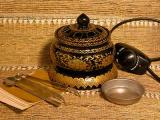
Golden Lotus Incense Heater is one of Katlyn’s most popular items
Katlyn: Perhaps one of my favorite parts of the incense making process is evolving and creating the intention and theme. Working to find the perfect match of vision, purpose and fragrance. Most know I am a very visual person so the image the scent conjures is very meaningful to me, as I hope it is to my customers. Conjure is a key word, to weave an enchantment with scented smoke that invokes a mood, a spell or even a goddess. My incense is not compounded until the name and intention are fully formed.
Do you have any recommendations for someone just starting to explore incense?
Andrew: For us, the process has required a great deal of focused education, experimentation and patience, which can be humbling to say the least. Beyond studying the ingredients and science of blending, my recommendation is to define an idea to guide the creative process. With a commitment to a concept, the fun and decisions easily follow. Never let the momentary failures overshadow the joy of making work that brings happiness to others.
Catamara: For the type of work I do, I would suggest acquiring any books possible about esoteric herbalism, ethno botany and plant folklore. There is no ‘right’ way or ‘one’ way in this art. For me it has been a very intuitive process though research on the plants and their use in magic and folklore has been very helpful. Experiment! Experiment! Experiment! And TAKE NOTES! Write down all formulations and pay attention to the results upon burning. I would also most definitely suggest paying attention to plants in your everyday life. They surround you. They have much to share through every season of the year and being aware of the cycle is a potent aspect in learning what parts of the plant to work with in your blends.
JK: I think it is wise to simply cut to the chase. Don’t bother exploring cheap junk. Avoid heavy use of synthetics – practically everything of commercial Indian and Middle Eastern origin. If you know you want something with Soul – follow the price tags. In the world of Incense, price is generally a good reflection of the quality of the raw materials used. Personally – if you had to pick one thing, I’d suggest exploring Japanese compositions and companies. If you were looking to explore a bit deeper by experiencing the foundational materials upon which the best incense is built – check out my selection of Mysore and Indian Sandalwoods and various agarwoods from around the world. I also make a fair amount of Custom Attars, as well as Custom Nerikoh (a form of Japanese incense compounding), Arabian Bakhoors, and a unique hybrid of scenting agarwood chips in the Japanese palette borrowing from some Arabian-inspired techniques. Many clients take advantage of this unique service I offer – best to just shoot me a message and inquire! There is a whole world of ingredients and traditions to explore – and all of written history attesting to the use of incense going back at least 10,000 years. Lots of reading and burning ahead of you!
Katlyn: Start with a good electric incense heater and premium quality single resins and precious woods, experiment and see what appeals to you. Splurge and get some of the finest Japanese sticks. All resins are not created equal, you get what you pay for, and fine woods are hard to find, it is always a bit of a “quest.” Never under estimate a good stick of Palo Santo—it can change your world. There are “good smell” day and “bad smell” days, something that seemed bland or unappealing one day can be magnificent the next day… Don’t trust recipes you read in most books, the majority of burning herbs (leaves) will smelled just like that, burning leaves. When in doubt about an incense or want read reviews, or get advice on techniques and styles go to Olfactory Rescue Service. It is a treasure trove of information. Have a favorite perfume or essential oil you want to make into an incense very quickly? Simply put a drop or two on a chip of Sandalwood and put it on an Electric heater. If you want to try your hand at making your own more complex incense go to this very helpful site Incense Making.
Dear readers, if you have a favorite incense please light some, take a quiet moment, count the good things, and have a blessed new year!
—Dr. Elise Pearlstine, Editor and Perfumer for Tambela.
For our Incense Draw here are four incense gifts from our talented incense-makers:
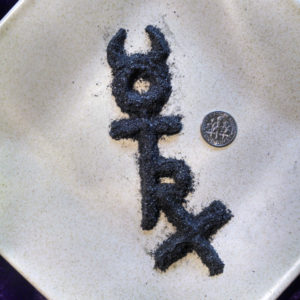
WORLDWIDE: Catamara of Rosarium Blends Mercury Retrograde Self Igniting Sigil Incense and The Rosarium Incense
Editor’s Note: Mercury is in Retrograde on December 19, 2016 and is already in pre-shadow. As someone who has seen technologyfails and communications break during this time… you may want to hedge your bets here.
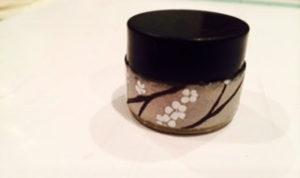
Rising Phoenix MuskRoseBakhoor
WORLDWIDE: The Rising Phoenix Group: A bottle of Musk Rose Bakhoor and Indian Sandalwood Billets
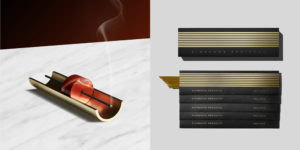
WORLDWIDE:Cinnamon Projects: Incense Series 01 Box with 10 sticks of each of their 5 scents
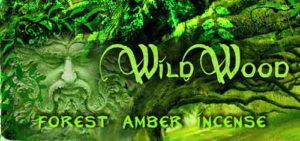
USA Only: Mermade Magickal Arts Wild Wood Incense with notes of fir, spruce, and cedar for the scent of the evergreen Yule tree.
To be eligible you must be a registered CaFleureBon reader, you can register here. Please leave a comment with what you learned about the art of creating incense as another form of perfume for your environment or yourself, and as many of these you would like to win. Draw closes December 17, 2016.
We announce the winners on our site and on our Facebook page, so Like Cafleurebon and use our RSS feed…or your dream prize will be just spilled perfume
